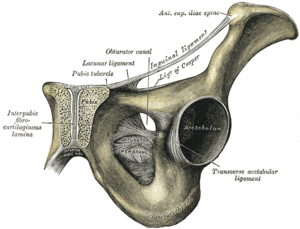Osteitis Pubis
Introduction[edit | edit source]
Osteitis pubis is a painful and chronic condition that is common in athletes affecting the pubic symphysis and parasymphyseal bone and it occurs after athletic activity.[1] It is actually an overuse condition caused by abnormal muscle forces acting on the pubic symphysis.[2] It causes pelvic pain and local tenderness over the pubic symphysis. It commonly occurs in athletes who participate in sports involving kicking, twisting, pivoting, cutting, and during abrupt directional changes. Osteitis pubis has been described in soccer, rugby, ice hockey, distance running players.[3]
Clinically Relevant Anatomy[edit | edit source]
The pubic symphysis is found anteriorly between adjacent pubic bounds covered in hyaline cartilage. It is stabilized by the superior pubic ligament and inferior pubic ligament.[Gray's anatomy]
Mechanism of Injury[edit | edit source]
The Centre of gravity of the body is located within the pelvis that’s why it is greatly stressed in all athletic activities. The biomechanical forces are applied through the pelvis of an athlete during kicking, acceleration and deceleration which increases the incidence of osteitis pubis. These forces cause chronic overloading of the pubic symphysis and parasymphyseal bone leading to a bony stress reaction.[4]
Clinical Presentation[edit | edit source]
An athlete with osteitis pubis presents with anterior and medial groin pain or it may be located directly over the pubic symphysis. Pain may also occur in the lower abdominal muscles, adductor region, perineal region, inguinal, and scrotum which is aggravated by running, cutting, hip adduction, flexion against resistance, and by activities that causes loading on the rectus abdominis. [1]
Diagnosis[edit | edit source]
On palpation, tenderness is common over the symphyseal region. Several tests are performed such as the pubic symphysis gap test with isometric adductor contraction and lateral compression test. Some provocation tests are helpful i.e single adductor, squeeze, and bilateral adductor tests(best) for the assessment of chronic groin pain. Clinical findings can also include Positive FABER test, restricted range of hip motion, sacroiliac joint dysfunction, and weakness of abductor or adductor muscles. Along with that radiographs, MRI, triple-phase scintigraphy confirms the diagnosis and excludes any other cause of groin pain.[3]
Differential Diagnosis[edit | edit source]
- Direct inguinal hernia,
- Indirect inguinal hernia,
- Sports hernia
- Athletic pubalgia,
- Adductor or iliopsoas injury,
- Pelvic stress fracture,
- Femoral neck stress fracture,
- Lumbar spine referred pain,
- Ilioinguinal neuralgia,
- Osteomyelitis can be considered but less common cause in athletes.[4]
Epidemiology[edit | edit source]
Osteitis pubis is a common cause of groin pain in athletes. The incidence in athletes is 0.5%–8%, with a higher incidence in distance runners and athletes participating in kicking sports, mostly in male soccer players with 10%–18% of injuries per year.[3]
Management and Return to Sport[edit | edit source]
Osteitis pubis is a self-limiting condition that improves by rest. Groin pain in osteitis pubis takes longer to resolve requiring extended period of rest but this is not possible for athletes. So treatment can vary from a conservative approach to surgical procedures depending upon the condition.
Conservative treatment[edit | edit source]
Conservative treatment includes rest, ice, reduced activity, anti-inflammatory drugs followed by an extensive rehabilitation program. The main aim is to correct muscular imbalances around the pubic symphysis which involves stretching and pelvic muscles strengthening. Physical therapy involving multimodal rehabilitation program is prescribed. In this program, patients are moved through different protocol stages after they are able to exercise without pain.
- Stage 1: This stage focuses on pain control and improving lumbo-pelvic stability. Stretching is performed except adductor and ischiopubic muscles. Cycling on an exercise bike is also started.[3][6]
- Stage 2: It involves using a swiss ball for resistance and strengthening exercises of the pelvis, abdominal, and gluteal muscles.[3][6]
- Stage 3 and 4: These include eccentric hip exercise, lunges, squats, and side-stepping with bands are done. Running is increased that involves a change of direction and pace. Kicking is only allowed at the end of the stage.[3][6] Most athletes return to the pre-injury level within 3 months(4 to 14 weeks) while successful follow-up may take 6 to 14 months.[7]
Injection Therapy[edit | edit source]
For the treatment of osteitis pubis, Corticosteriod injections into pubic symphysis are also used as an additional approach to accelerate return to sport. Some studies have reported pain relief at short-term follow-up but most are non-responders. So there is no strong evidence regarding the efficacy of short and long-term use of corticosteroids.[3]
Surgical Treatment[edit | edit source]
Surgery is performed only after conservative management fails. It may be indicated after at least 3 months of well-conduced rehabilitation program.Surgical intervention is required for 5%–10% of patients refractory to conservative approaches.[3]
References[edit | edit source]
- ↑ 1.0 1.1 Hiti CJ, Stevens KJ, Jamati MK, Garza D, Matheson GO. Athletic osteitis pubis. Sports medicine. 2011 May 1;41(5):361-76.
- ↑ Johnson R. Osteitis pubis. Current sports medicine reports. 2003 Mar 1;2(2):98-102.
- ↑ 3.0 3.1 3.2 3.3 3.4 3.5 3.6 3.7 Via AG, Frizziero A, Finotti P, Oliva F, Randelli F, Maffulli N. Management of osteitis pubis in athletes: rehabilitation and return to training–a review of the most recent literature. Open Access Journal of Sports Medicine. 2019;10:1.
- ↑ 4.0 4.1 Beatty T. Osteitis pubis in athletes. Current sports medicine reports. 2012 Mar 1;11(2):96-8.
- ↑ Osteitis Pubis. Available from: https://www.youtube.com/watch?v=dzI18kubrZE
- ↑ 6.0 6.1 6.2 Jardí J, Rodas G, Pedret C, Til L, Cusí M, Malliaropoulos N, Del Buono A, Maffulli N. Osteitis pubis: can early return to elite competition be contemplated?. Translational Medicine@ UniSa. 2014 Sep;10:52.
- ↑ Cheatham SW, Kolber MJ, Shimamura KK. The effectiveness of nonoperative rehabilitation programs for athletes diagnosed with osteitis pubis. Journal of sport rehabilitation. 2016 Dec 1;25(4):399-403.
- ↑ Pelvic pain Rehab Video-Osteitis Pubis. Available from: https://www.youtube.com/watch?v=7U5GLjR92Dk
.







